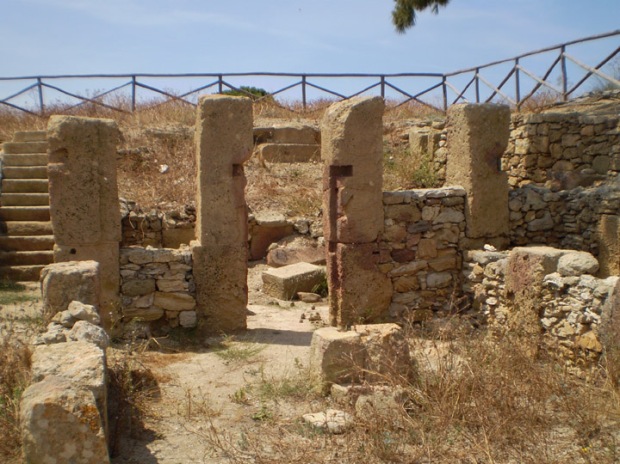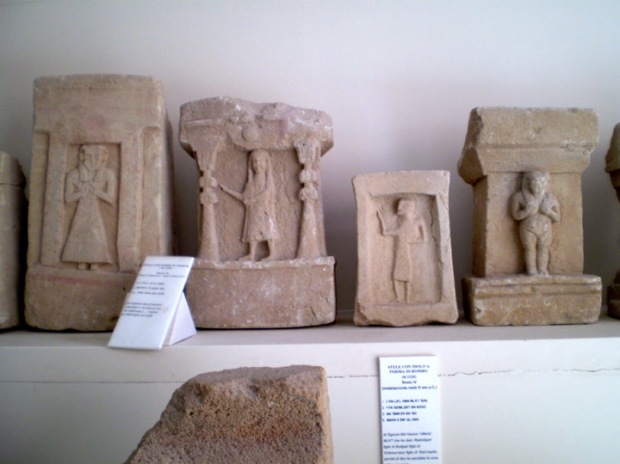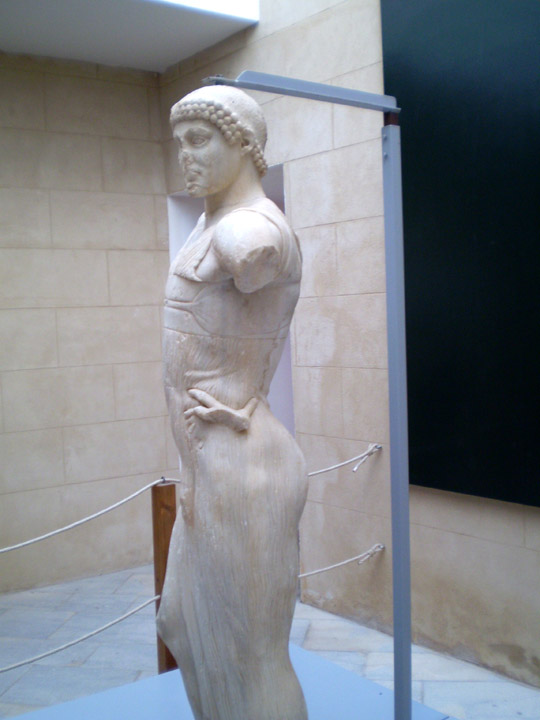 |
| The Hercules monument in Kassel, which is listed in the UNESCO Worldheritage list! Delisted by FaceBook because of his "naked butt" ... ridiculous! overbearing! hypocritic! - courtsey GRIMM HEIMAT NORDHESSEN |
 |
| The UNESCO Worldheritage HERKULES - Source: YouTube |
 |
| The statue of the beautiful and tantalizing Charoteer - own collection |
But what had been most thrilling to me was the Charioteer of Mozia or Motya. Some time prior to this cruise I watched an art TV show, where the statue was depicted.
 |
| Ruins of an ancient house, built by a Carthagian citizen, on Mozia, Sicily - own collection |
Mozia, the
small but powerful island, is situated on the Western tip of Sicily, between Marsala and Trapani, and is protected by a natural lagoon. It is a totally
unassuming place, only accessible by a little water taxi, or our Zodiacs, which we boarded from ANDREA, but has quite a
past. The Phoenician city of Mozia (or Motya) was founded in the 8th
century BC, taking advantage of the island’s natural defenses. The city
was a profitable trading community for centuries but later, regional
conflict between the Greeks and Carthaginians spilled over and
ultimately led to its destruction in 397 BC. The citizens must have
known the end was imminent because they buried one of their greatest treasure -
a white marble statue of a charoteer - in advance of the invasion within the walls to strengthen them, when Dionysios I, the Greek ruler of Syracuse, invaded in retaliation. In the 20th
century, 1979, the statue was discovered, excavated and nicknamed "The God of Mozia".
 |
| Early Phoenician funerary markers from the Mozia Archaeological Museum |
The architectural ruins on Mozia are nice and include a massive outer
wall, paved main streets, domestic spaces and the foundations of a
large temple. The museum on the island displays a collection of small
Phoenician and Greek items which in general are early and relatively
primitive in design. There are some interesting masks believed to be
related to a funerary or human sacrifice ritual (but more on that
later!) In this unassuming museum, you would never expect to see a
sculpture of such incredible skill and style - a sculpture that in many
ways defies art historical conventions.
We had not been informed, despite I knew in advance, about the "find" to see in the museum. I made a beeline to the special room. And while I was standing awed in front, the other cruise passengers, most elderly women, got so surprised and screem nearly in joy, seeing this statue of am man, clothed but all to be seen. One of the husbands grumbled, "What a fuss she makes! As if she has never seen a nude man." Perhaps not that beautiful ...
Normally Greek olympians went in the nude for their olympic games, what a pitty they don´t do any longer ... The charoteers wore the xystis, as only for these games women had been allowed to. Other games had been by death penalty for the women without them.
Charioteer of Mozia is a very rare surviving example of
an original Greek victor’s statue and is believed to represent the
winner of a chariot race that took place some 2,500 years ago. He was
found in 1979 amid excavations on the tiny island, which was a Phoenician stronghold in ancient
times and a region renowned for breeding horses.
 |
| The God of Mozia, circa X BC on display at the Mozia Archaeological Museum, Mozia, Sicily |
The Charoteer of Mozia is about 1,83 m / 6ft tall with his now
lost feet. It is a life size statue, that young man must have been impressive. The young man stands in an exaggerated and
provocative contrapposto stance. He wears a thin, diaphanous tunic, a xystis,
typical for charoteers in those days, which is held tight against his chest with an elaborate belt over his chest. The xystis was a garment that covered the entire body, and was fastened with a
simple belt. Two straps crossed high at the racers back preventing the
fabric from `ballooning´ during the race. The broad belt on to which the reins would have been fastened - on the
statue were secured via fixings in the two holes in the belt at the
front. This prevented the reins from being pulled out of the hands, but
also dangerously, prevented the charioteer from being thrown free in any
crash..
His hand
digs sexually provoking into the flesh of his hip with shocking realism. Similar as to the later gladitors the winners of the olympian games got not only fame and sometimes great wealth, they got other offers too, not accompanying a symposion, but for some other activities too ...
 |
| Close up of the hand squeezing the hip of “The God of Mozia” |

The execution of the sculpture has all the sophistication of the
Classical Greek style but with a unique erotic twist. Males tend to either be nude or robed in more sturdy tunics while women had more ephemeral robes. The God of Mozia
has a very atypical, animated pose. Like he is offering himself for pleasure, or provoking advances. Figural extremes were usually
reserved for Bacchus (there is no English Wiki site available ... I am wondering) and his wild followers. Even then, these
expressive pieces do not appear until the height of the Classical Greek
period where The God of Mozia is much older.

As well as the body of the figure is executed, the exaggerated almond eyes and the tight bundles of hair around The God of Mozia‘s face is reminiscent of archaic Greek pieces such as the Kouros Boy. The cap of his head is rough and likely would have been adorned with an
extemporaneous crown. The practice of mounting separate head-pieces or
other adornment on marble statues was in practice in the pre-Classical
period of Greek sculpture. You can see two example below.
Incorporating elements of archaic and classical Greek sculpture, The God of Mozia is a true cross-over piece.
 |
| An early archaic Kouros, in a stiff pose, Egyptian influenced, only the left leg is put forward, the similarities to Egyptian statues are to be seen - own collection |
 |
| A classical Kouros from the 6th century BC, the body is beginning to get a move, and the body is more defined as the Greeks learned about the body and tried to get the ideal - own collection |
 |
The Moschophoros of the Acropolis, ca 570 BC, Acropolis Museum, Athens, Greece - own cllection
This statue is reminding me of various statues where St. Christopher is bearing Jesus ...
|
How are we to interpret this figure and more importantly who is he
suppose to be? Since Phoenician sculptors were not nearly this
talented, it is believed that the figure was either commission by Mozia
of Greek sculptors or was stolen from the Greeks and brought to the
island. I tend to think the statue was commissioned thus explaining the
unique mix of masculinity and femininity, and classical and ancient
styles which seems more disjointed than the work executed by the
Greeks. Given the execution and
the lack of any other art of this caliber on Mozia, I think this could have been a cult deity figure. Or an afficionado of beauty. But this figure is commonly believed to be a
charioteer given the style of belt he is wearing. But I am not the expert, I have only my own private thought about.
 |
| The back of The God of Mozia - own collection |
Amazingly, the God of Mozia has left his island and is on tour right now! He and other treasures of Sicily had been on display at the Getty Villa in Los Angeles until Aug 19th, 2013 as part of the 2013 Year of Italian culture.
 |
| The Motya Charioteer made by a greek sculptor in sicily about 460-450 bc found in 1979 on the island of motya winning at the ancient games - courtsey The BRITISH MUSEUM |
 |
Backside
of The Motya Charioteer, made by a Greek sculptor in Sicily, about
460-450 BC, found 1979 on the Sicilian island Motya (Mozia), Winning at
the ancient Games - courtsey The BRITISH MUSEUM
|


Comments
Post a Comment